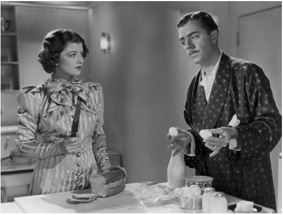|
|
Chapter Two: After the Thin ManBy Brett BeachJuly 14, 2009
William Powell and Myrna Loy had that kind of chemistry resulting in a partnership of 14 films together over a dozen years, three of them filmed and released in 1934 alone. The first of these just happened to be Manhattan Melodrama, which, as astute summer moviegoers, history buffs and/or Johnny Depp fanatics know, is the film that John Dillinger was watching the evening he was gunned to death outside the Biograph Theater. Powell and Loy were two-thirds of a love triangle in that tale. The director of Melodrama, Woodbridge Strong "W.S." Van Dyke (affectionately known as "One-Take Woody" for his ability to bring in movies under budget and on short shooting schedules) saw what they had and convinced head of MGM Studios Louis Mayer that they would be perfect as husband and wife detectives in a the adaptation of a detective novel that had come out only earlier that year. Van Dyke was granted 21 days to shoot and finished in 12. The result, The Thin Man, was not only a commercial success but garnered four Oscar nominations: for the film, Powell's performance (his first), Van Dyke's direction (his first), and for the screenplay by husband and wife team Albert Hackett and Frances Goodrich (also their first). Hackett and Goodrich adapted their screenplay from Dashiell Hammett's novel of the same name, which oddly enough, turned out to be the last full-length work he would ever complete. Although Hammett's subsequent works did not continue the adventures of his lead characters, Powell and Loy teamed up five more times in further Thin Man sagas, the second of which, After The Thin Man, came out at Christmastime in 1936.
|

|
|
|

|
Friday, November 1, 2024
© 2024 Box Office Prophets, a division of One Of Us, Inc.


